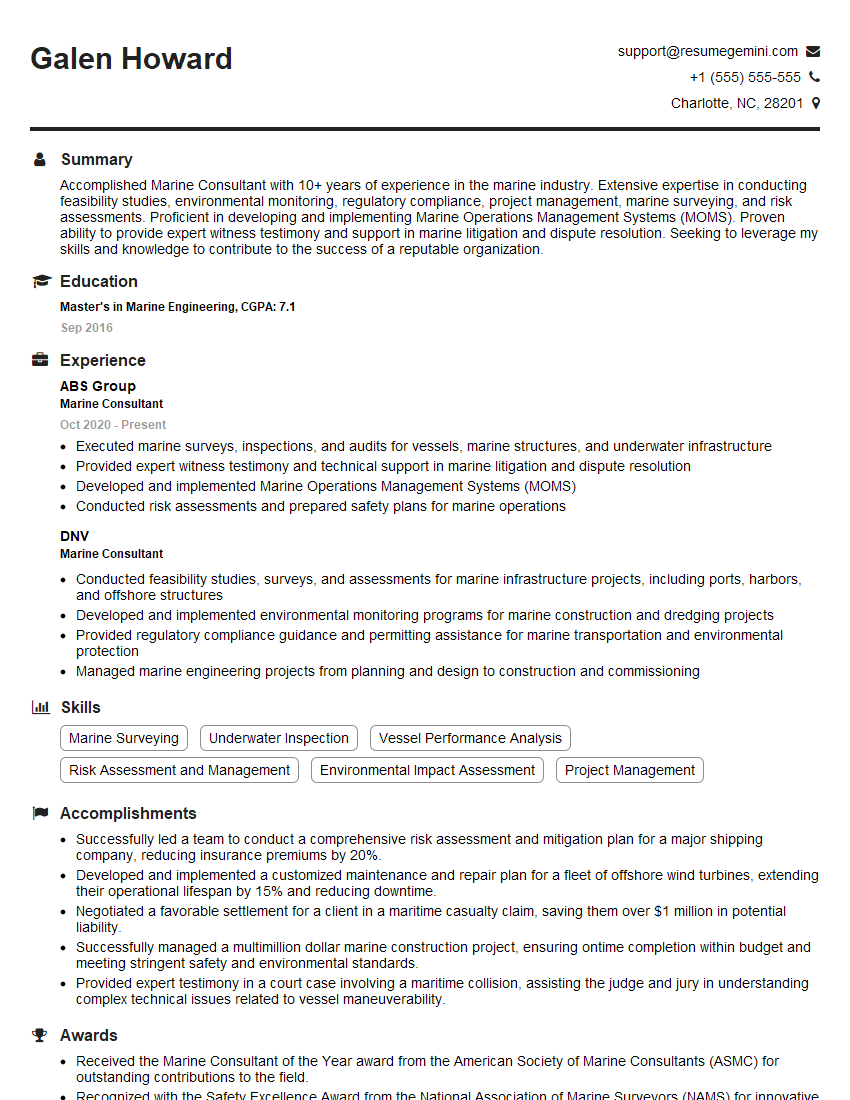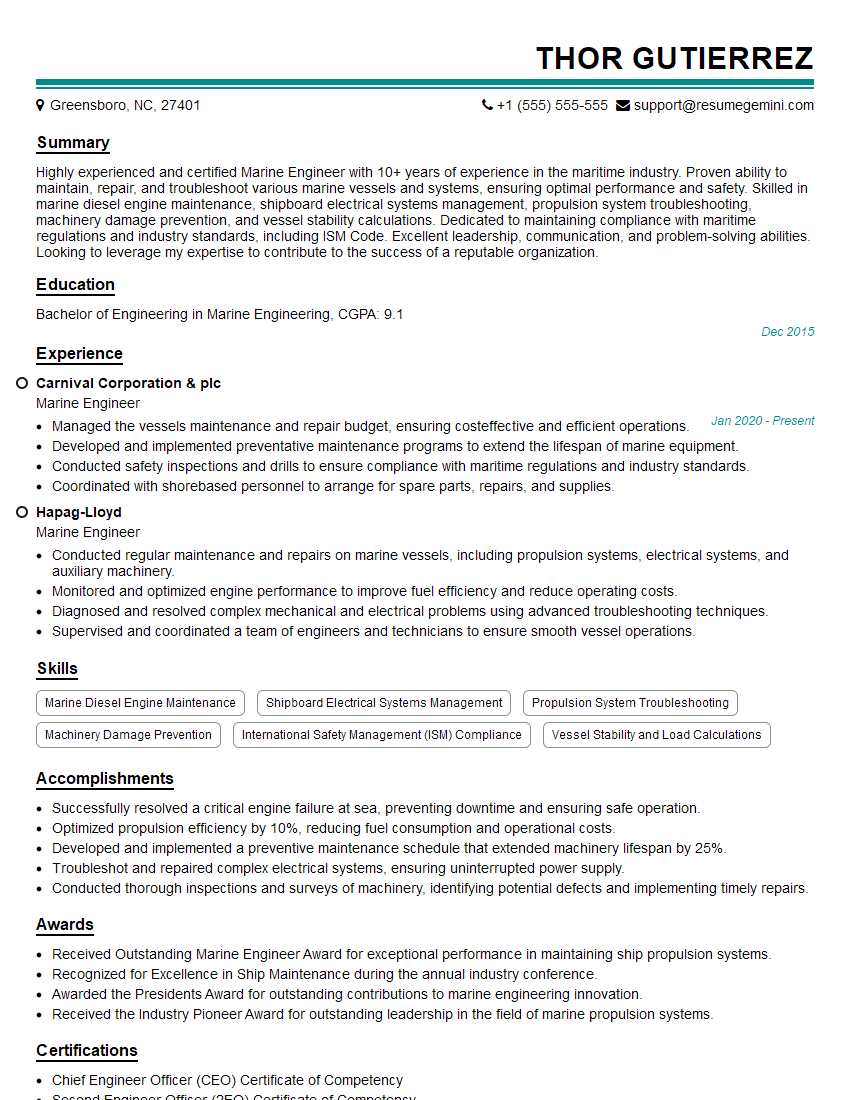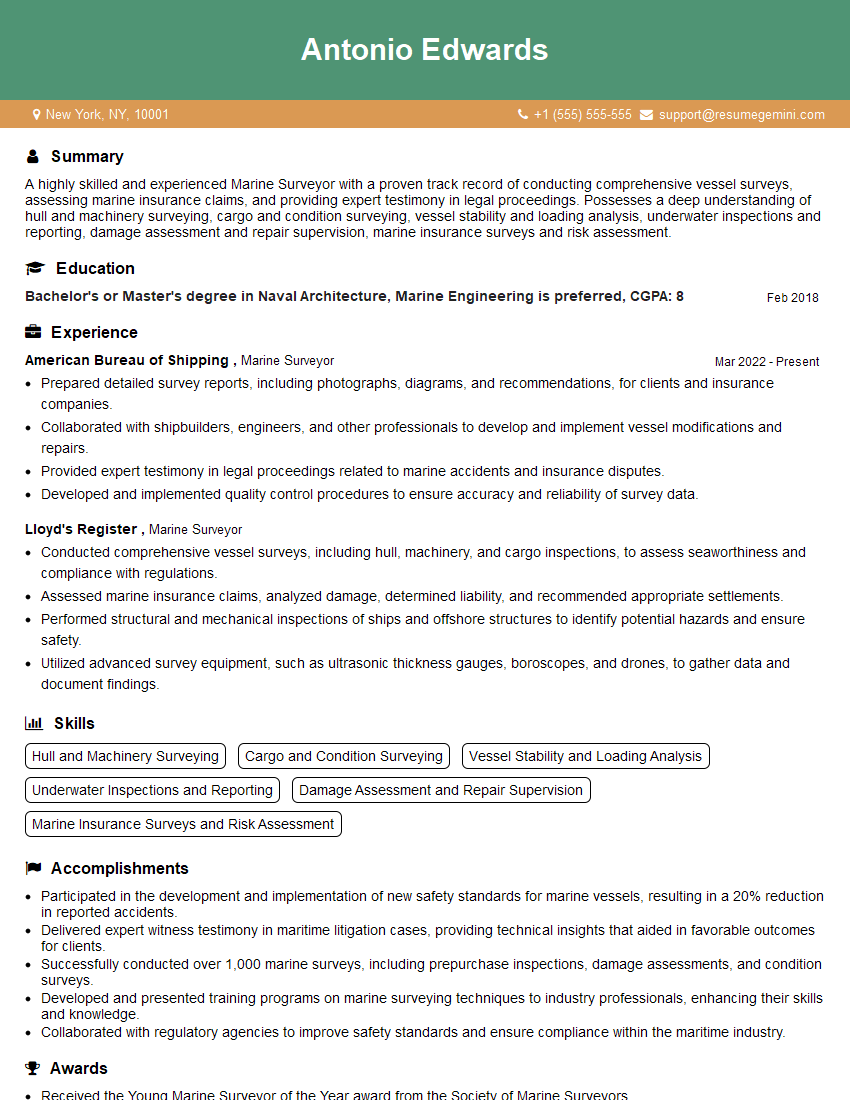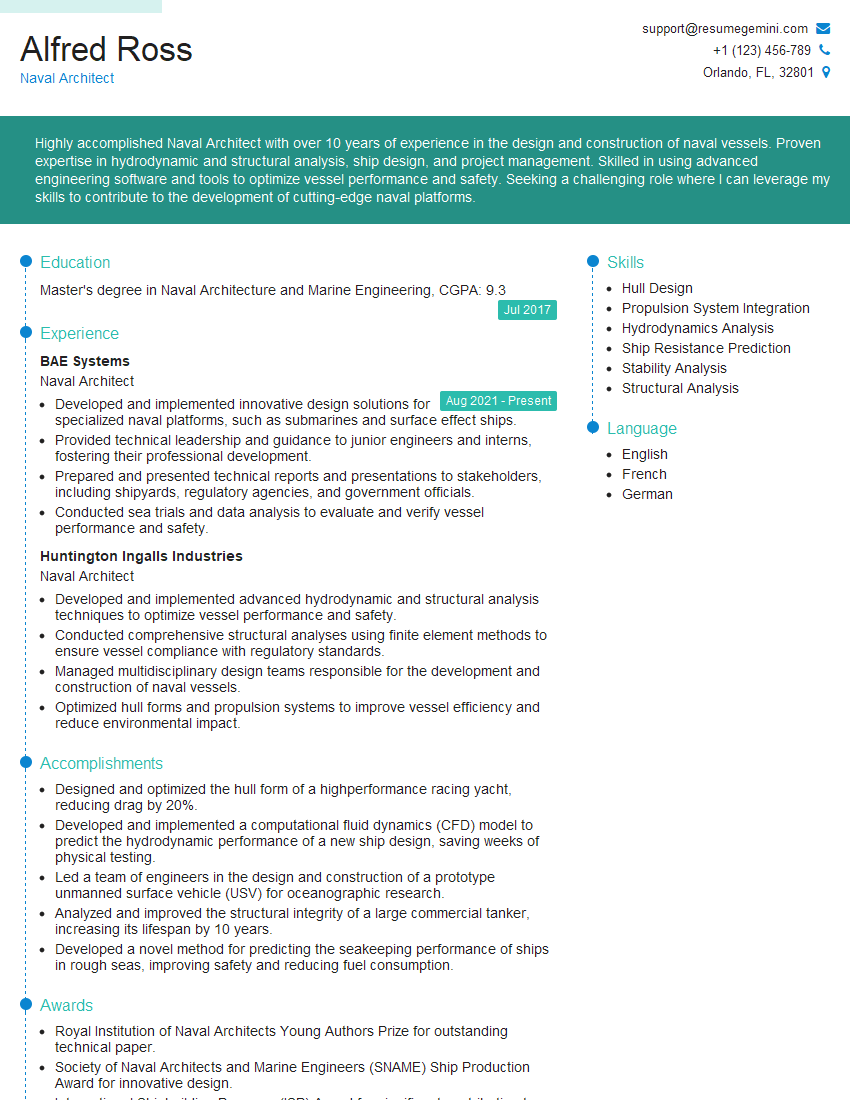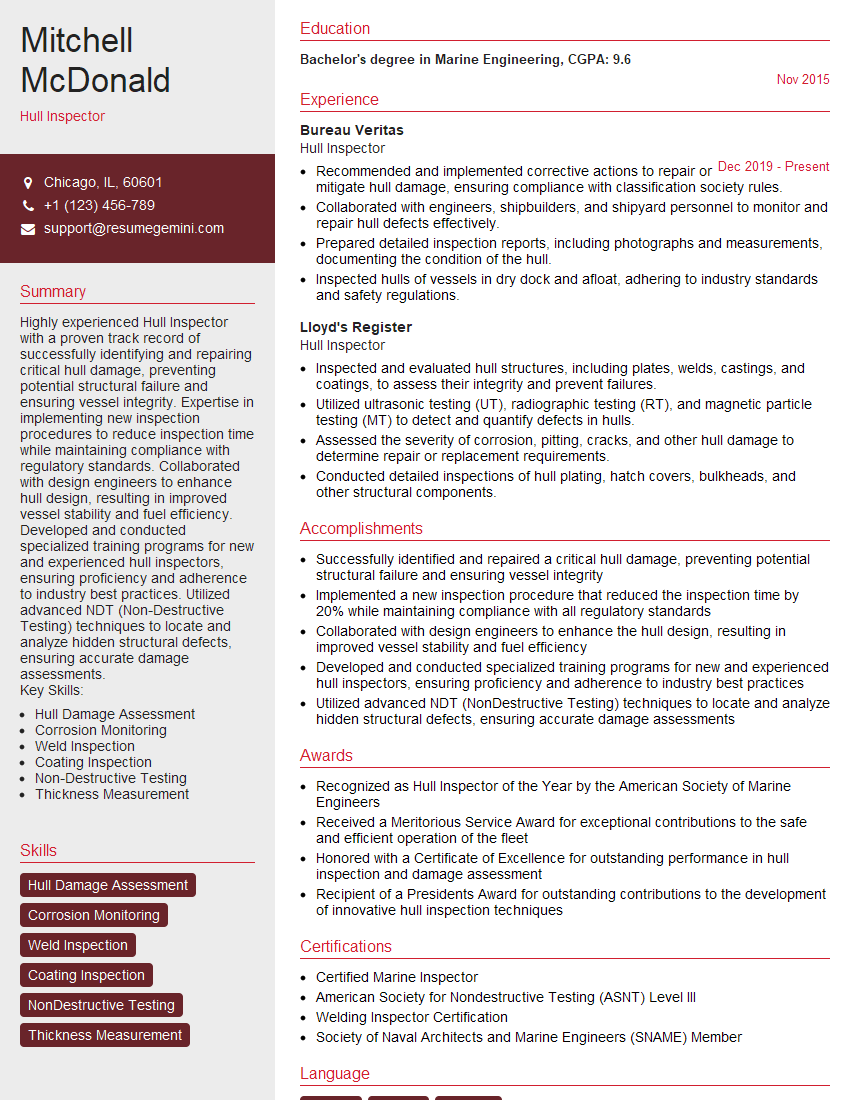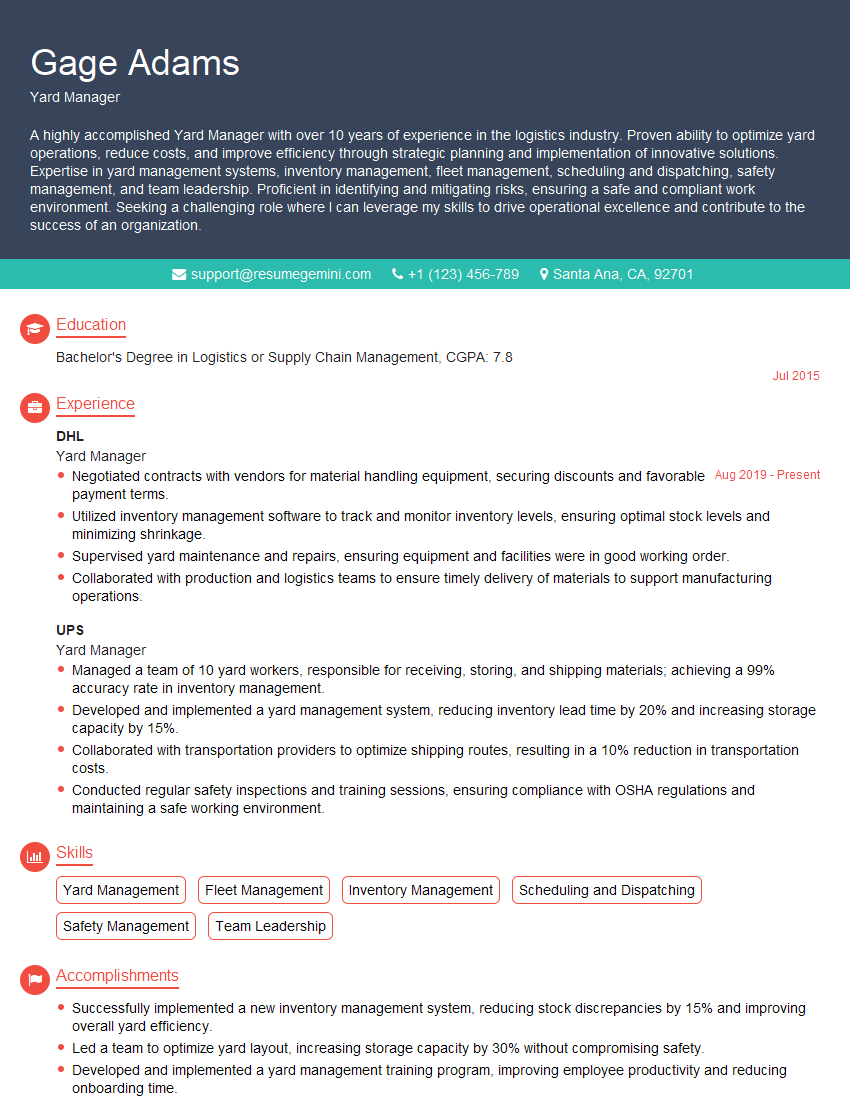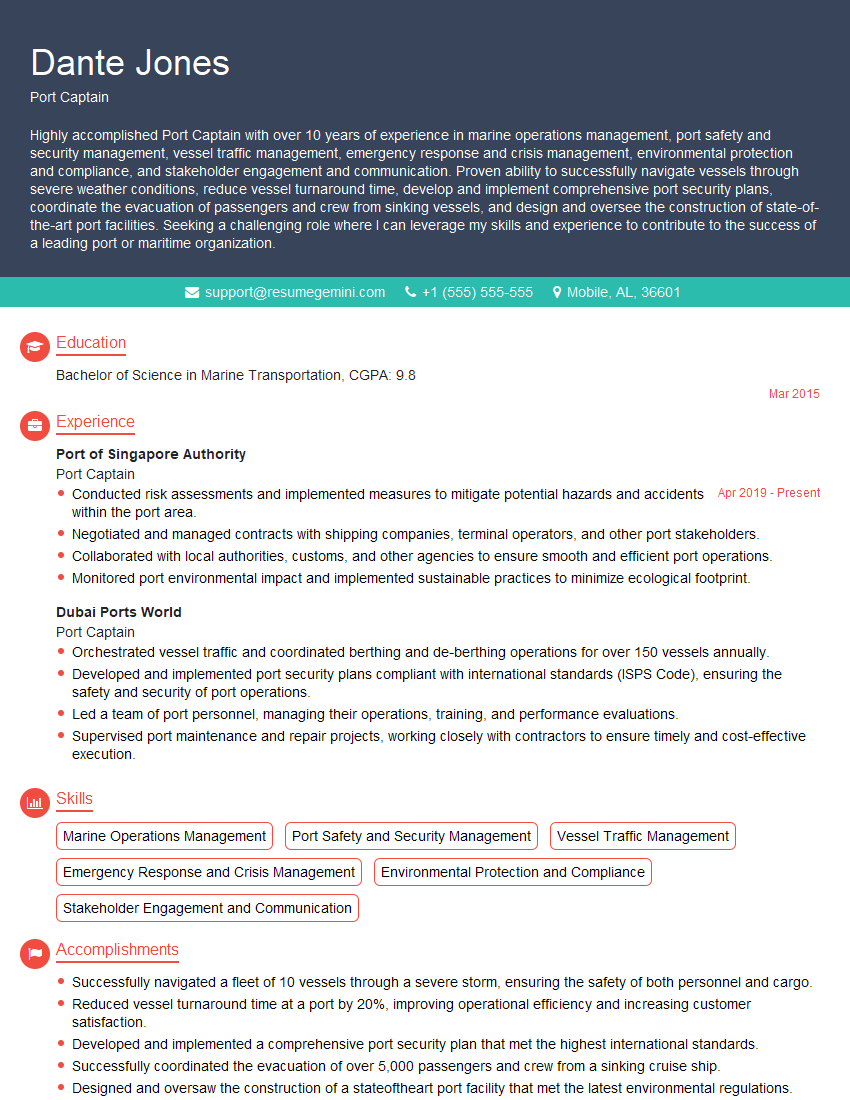The right preparation can turn an interview into an opportunity to showcase your expertise. This guide to Hull and deck inspections interview questions is your ultimate resource, providing key insights and tips to help you ace your responses and stand out as a top candidate.
Questions Asked in Hull and deck inspections Interview
Q 1. Describe your experience with various hull plating types and their associated corrosion risks.
Hull plating materials significantly influence corrosion risk. Common types include mild steel, high-strength steel, and stainless steel. Mild steel, while cost-effective, is highly susceptible to corrosion, especially in saltwater environments. High-strength steel offers improved strength but can be prone to stress corrosion cracking if not properly managed. Stainless steel alloys possess superior corrosion resistance but are more expensive.
- Mild Steel: This is the most common material, but requires diligent maintenance like regular painting and cathodic protection to mitigate rust. Imagine a car body – if you don’t paint it, it rusts. The same principle applies, but on a far larger scale.
- High-Strength Steel: Used where weight reduction is crucial. Its higher strength means it can be thinner for the same structural capacity, but its susceptibility to stress corrosion cracking necessitates careful inspection for even minor surface imperfections that could initiate cracks.
- Stainless Steel: Offers superior corrosion resistance due to its chromium content. However, different grades possess varying levels of corrosion resistance. Certain marine environments can still degrade even stainless steel over time, particularly in areas of stagnant water or crevices where debris can accumulate.
Assessing corrosion risk involves considering factors beyond the material itself, including the vessel’s operational profile (e.g., time spent in ballast water), environmental conditions (temperature, salinity), and the effectiveness of existing corrosion protection systems.
Q 2. Explain the different methods used for non-destructive testing (NDT) in hull and deck inspections.
Non-destructive testing (NDT) is crucial for assessing hull and deck integrity without causing damage. Several methods are employed:
- Visual Inspection (VI): This is the most basic method, involving a thorough visual examination for signs of corrosion, damage, or deformation. It’s the first step in any inspection and forms the foundation for further investigations.
- Ultrasonic Testing (UT): This uses high-frequency sound waves to detect internal flaws like cracks or voids. Think of it like sonar – the waves bounce back differently depending on the material’s density and integrity. It’s particularly useful for detecting lamination in composite materials.
- Magnetic Particle Inspection (MPI): This method uses magnetic fields to detect surface and near-surface cracks in ferromagnetic materials (like steel). Iron filings are applied, and cracks are highlighted as the particles accumulate within the flaw.
- Radiographic Testing (RT): Uses X-rays or gamma rays to create images of the internal structure. This allows for the detection of weld defects, corrosion, and other internal flaws. It’s similar to a medical X-ray but for the vessel’s structure.
- Electromagnetic Testing (ET): This measures changes in electromagnetic fields to detect corrosion and other defects. Eddy current testing is a common type of ET used to assess the thickness and integrity of conductive materials. It is quick and efficient for large surface areas.
The choice of NDT method depends on factors like the material being inspected, the type of defect being sought, and access limitations. Often, a combination of methods is used for a comprehensive assessment.
Q 3. What are the common signs of structural weakness in a vessel’s hull or deck?
Structural weakness in a hull or deck manifests in several ways:
- Visible Deformation: Bulges, dents, or excessive sagging are clear indicators of structural compromise. Imagine a dented car body – it’s weakened and less able to withstand further impacts.
- Corrosion: Pitting, scaling, or rust indicate material degradation, reducing the structural strength. Think of rust eating away at a support beam – its strength is significantly compromised.
- Cracking: Surface cracks or fatigue cracks (originating from cyclic loading) indicate weakening of the material and pose a serious risk of failure.
- Excessive Vibration or Noise: Unusual vibrations or noises during operation might suggest looseness or damage in structural members.
- Signs of Leakage: Water ingress through cracks or corroded areas points to structural compromise and potential further deterioration.
- Misalignment: Incorrect alignment of structural components suggests damage or improper assembly, potentially weakening the structure overall.
These signs, individually or in combination, require thorough investigation to assess the extent of damage and determine necessary repairs.
Q 4. How do you assess the condition of welds during a hull and deck inspection?
Weld assessment is critical because welds are crucial structural elements. The inspection involves a multi-faceted approach:
- Visual Inspection: Checking for cracks, porosity, undercuts, lack of fusion, and other visible defects. This is often the first and most important step.
- NDT Methods: UT, RT, and MPI are used to detect internal flaws that may not be visible on the surface. RT is particularly useful for identifying internal porosity or lack of fusion.
- Dimensional Checks: Verifying that the weld meets the specified dimensions, including weld bead height, width, and penetration depth. Deviations can indicate improper welding procedures or defects.
- Hardness Testing: Measuring the hardness of the weld metal to ensure it meets the required specifications. Excessive hardness can indicate cracking susceptibility.
Documentation is key. All findings, including the NDT results and photographs, must be meticulously recorded. This record provides a clear picture of the weld’s condition and informs decisions regarding repair or replacement.
Q 5. What are the typical maintenance procedures for preventing corrosion on a vessel’s hull and deck?
Preventing corrosion involves a proactive maintenance strategy encompassing:
- Regular Cleaning: Removing salt deposits, marine growth, and other contaminants prevents corrosive agents from accumulating on the hull and deck surfaces. Think of regularly washing your car to prevent rust.
- Protective Coatings: Applying high-quality marine paints and coatings provides a barrier against seawater and atmospheric corrosion. The selection of the coating should be based on the environment and the hull material.
- Cathodic Protection: This involves using sacrificial anodes (like zinc) or impressed current systems to protect the hull from corrosion. It acts like a shield, preventing the hull from being the main target for corrosion.
- Regular Inspections: Conducting routine inspections, including visual inspections and NDT, helps identify corrosion at an early stage, allowing for timely intervention and preventing extensive damage.
- Proper Drainage: Ensuring adequate drainage prevents the accumulation of water that could accelerate corrosion. Water pooling in crevices or on decks is a significant corrosion risk.
- Repair of Damaged Areas: Promptly repairing any damage to the hull or deck coatings prevents corrosion from spreading.
A well-defined maintenance plan, tailored to the vessel’s operating environment and material composition, is crucial for long-term corrosion prevention.
Q 6. Explain the significance of ballast water management in relation to hull integrity.
Ballast water management is directly linked to hull integrity. Ballast water, taken on for stability and discharged in port, can introduce invasive species and corrosive agents into the vessel’s system.
- Corrosion: Ballast water can contain aggressive chemicals, and its high salinity can contribute to corrosion. The different water chemistries in different locations can lead to localized corrosion.
- Biofouling: Marine organisms that thrive in ballast water can accumulate on the hull, increasing frictional drag and causing pitting corrosion. This can damage the hull structure over time.
- Internal Corrosion: Ballast tanks themselves can experience significant corrosion due to stagnant water, varying salinity, and the presence of oxygen. This internal corrosion can weaken the tank structure and potentially lead to leaks.
Effective ballast water management systems, including treatment technologies, are critical for minimizing the introduction of corrosive agents and organisms, protecting hull integrity, and preventing environmental damage.
Q 7. How would you identify and document damage caused by grounding or collision?
Identifying and documenting grounding or collision damage requires a systematic approach:
- Initial Assessment: A visual survey should be conducted to identify the extent and location of the damage. This might involve using drones or underwater inspection equipment.
- Detailed Documentation: Photographs, sketches, and detailed written descriptions should be created to capture the nature and extent of the damage. This might involve creating 3D models to better represent the damaged area.
- NDT: UT, RT, or MPI can be used to evaluate the extent of damage beyond the visible surface. This helps to determine if the damage goes beyond what is seen on the surface.
- Thickness Measurements: Measuring the thickness of the plating in the damaged area helps assess the structural integrity and determine whether repairs are required.
- Stress Analysis: In cases of significant damage, a stress analysis might be needed to determine the structural implications and guide repair strategy.
The documentation must be thorough and accurate, complying with relevant regulations and providing a comprehensive record of the damage for insurance claims, repairs, and future inspections.
Q 8. What are the key regulations and standards relevant to hull and deck inspections (e.g., SOLAS, IMO)?
Hull and deck inspections are governed by a complex interplay of international conventions, national regulations, and classification society rules. The most prominent are the International Maritime Organization (IMO) regulations, particularly the International Convention for the Safety of Life at Sea (SOLAS), which sets minimum safety standards for ships. SOLAS Chapter II-1, specifically, deals with structural fire protection, fire detection, and fire extinguishing systems, directly impacting hull and deck integrity. The IMO’s Marine Environmental Protection Committee (MEPC) also plays a significant role, addressing regulations concerning ballast water management and the prevention of marine pollution – elements that frequently influence the condition of a hull and its associated coatings.
Beyond SOLAS and IMO, classification societies like DNV, ABS, Lloyd’s Register, and others have their own rules and guidelines that stipulate detailed requirements for hull and deck construction, maintenance, and inspection. These classifications are often mandatory for commercial vessels to operate and receive insurance. These standards delve into specifics such as acceptable corrosion levels, structural strength assessments, and the type of materials permitted. National maritime administrations, finally, may add their own regulations to comply with international standards while addressing local considerations.
- SOLAS: Sets minimum safety standards for ships, impacting hull and deck structural integrity and fire safety.
- IMO: Develops international standards for ship safety and marine environmental protection, impacting ballast water management and pollution prevention.
- Classification Societies: Provide detailed rules and guidelines for construction, maintenance, and inspection.
- National Maritime Administrations: Implement national regulations alongside international standards.
Q 9. Describe your experience using specialized inspection tools and equipment.
My experience encompasses a wide range of specialized inspection tools and equipment. I am proficient in using ultrasonic thickness gauges to measure the remaining thickness of hull plating and structural members, identifying potential corrosion or erosion. This allows for precise assessment of structural integrity and remaining lifespan. I also routinely employ magnetic particle inspection (MPI) and dye penetrant inspection (DPI) techniques to detect surface and near-surface cracks and flaws in welds and other critical components. These non-destructive testing (NDT) methods are crucial for early detection of defects that could lead to catastrophic failure. Furthermore, I utilize advanced digital imaging systems to capture detailed photos and video recordings of defects, creating a comprehensive visual record for documentation and analysis. My experience extends to using specialized climbing equipment and confined space entry procedures to safely reach and inspect hard-to-access areas of the hull and deck. For instance, I’ve used remotely operated vehicles (ROVs) for underwater hull inspections, significantly enhancing the efficiency and safety of assessing below-the-waterline areas.
Q 10. How do you prepare a detailed inspection report, including photographs and diagrams?
Preparing a detailed inspection report requires meticulous attention to detail and a standardized approach. I begin by defining the scope of the inspection, specifying the areas to be examined and the relevant standards to be applied. During the inspection, I meticulously record all observations, measurements, and findings using a standardized checklist. High-resolution digital photographs and sketches are taken to illustrate each defect, including its location, size, and type. Crucially, I use precise terminology and measurements in the report to avoid any ambiguity. The report is structured logically and systematically, typically including:
- Introduction: Details of the vessel, date of inspection, scope of work.
- Findings: Detailed description of all observed defects, supported by photographs, diagrams, and measurements. Severity of each defect is clearly classified.
- Analysis: Assessment of the significance of identified defects and their potential impact on the vessel’s structural integrity and safety.
- Recommendations: Detailed recommendations for repairs and/or maintenance, prioritizing critical issues.
- Conclusion: Summary of findings and overall assessment of the vessel’s condition.
For complex structural issues, I often use CAD software to create detailed diagrams showcasing the extent of damage and to aid in devising effective repair strategies.
Q 11. How do you prioritize repairs based on the severity and risk associated with identified defects?
Prioritizing repairs is a critical aspect of hull and deck inspections. I employ a risk-based approach, considering both the severity of the defect and its associated risk. Severity is assessed based on factors such as the size, location, and type of defect. Risk is determined by considering the potential consequences of failure, including the likelihood of structural collapse, loss of seaworthiness, or environmental damage. I use a matrix or scoring system to objectively rank defects based on these factors. For instance, a small crack in a non-critical area might receive a low priority, while significant corrosion in a load-bearing structural member would be considered high priority, demanding immediate attention. The repair priority is often communicated in a color-coded system within the report (e.g., red for immediate action, yellow for planned maintenance, green for monitoring).
Emergency repairs, like those dealing with immediate safety concerns, naturally take precedence over all others.
Q 12. What is your experience with different types of coatings used on hulls and decks?
My experience covers a wide spectrum of coatings used on hulls and decks, from traditional anti-fouling paints to advanced epoxy and polyurethane systems. I’m familiar with the properties and limitations of each, understanding their application methods, expected lifespan, and potential degradation mechanisms. Anti-fouling paints, designed to prevent marine growth, are crucial for minimizing hull friction and improving fuel efficiency. Epoxy coatings are widely used for their excellent corrosion resistance and durability, often applied to the hull plating to protect against seawater. Polyurethane coatings are valued for their flexibility and impact resistance, commonly used on deck surfaces to improve wear resistance. I’m also familiar with newer technologies such as self-polishing copolymers (SPC) which continuously release biocides to manage biofouling. Understanding the type of coating used, its condition, and any signs of degradation (e.g., blistering, peeling, chalking) is vital for assessing the hull and deck’s overall protective system. This allows me to advise on appropriate maintenance or recoating schedules.
Q 13. Explain the process of evaluating the structural integrity of bulkheads and transverse frames.
Evaluating the structural integrity of bulkheads and transverse frames involves a thorough visual inspection, coupled with detailed measurements and potentially NDT techniques. I begin by examining the surface for signs of corrosion, deformation, or damage. Then, I use ultrasonic thickness gauges to measure the remaining thickness of the structural members, comparing these measurements against the original design specifications and allowable corrosion limits. Deflections and misalignments are carefully measured using appropriate tools. For any suspected weakness or damage, I’d recommend further investigations using advanced NDT methods such as radiography or advanced ultrasonic techniques to reveal internal flaws. I meticulously document all findings, including photographs and diagrams illustrating any detected damage. The overall assessment considers not just individual component condition, but also the overall structural behavior under load, taking into account factors like framing arrangement, support conditions, and material properties. Any significant deviations from design parameters trigger immediate recommendations for repair or strengthening.
Q 14. How do you interpret and assess data from thickness measurements and ultrasonic testing?
Interpreting data from thickness measurements and ultrasonic testing requires a strong understanding of both the inspection techniques and the materials being tested. Ultrasonic testing (UT) provides information on both material thickness and the presence of internal flaws. The data is typically displayed as a waveform or numerical readout. I interpret the thickness measurements by comparing them to the original design specifications and the allowable corrosion limits defined by the relevant standards or classification society rules. Any significant reduction in thickness indicates corrosion or erosion and needs to be carefully assessed. The UT waveform shows the sound reflection from interfaces within the material. I look for indications of flaws, such as discontinuities in the waveform, indicating the presence of voids, cracks, or inclusions. The size and location of these flaws are important in determining their severity. My interpretation involves not just the raw data but also contextual factors such as the material’s properties, operating conditions, and the overall structural context of the component being inspected. A small reduction in thickness might be insignificant in a low-stress area but critically important in a highly stressed structural member.
Q 15. What are the common types of hull and deck corrosion and how are they addressed?
Hull and deck corrosion is a significant concern in maritime operations, impacting safety and vessel longevity. Common types include:
- Pitting Corrosion: Localized corrosion resulting in small pits or holes. Think of it like tiny craters forming on the surface. This is often caused by stagnant water or localized differences in electrical potential.
- Crevice Corrosion: Corrosion concentrated in narrow gaps or crevices where oxygen access is restricted. This is common in areas like bolted joints or under coatings.
- Galvanic Corrosion: Corrosion caused by the electrochemical interaction between dissimilar metals. Imagine a zinc anode protecting a steel hull – the zinc will corrode preferentially. Improper grounding or stray currents can exacerbate this.
- Uniform Corrosion: Corrosion that affects the entire surface area relatively uniformly. Think of a sheet of metal rusting evenly. This is often caused by exposure to aggressive environments.
Addressing these issues requires a multi-pronged approach: regular inspections, effective cleaning, protective coatings (like paints or zinc-based systems), cathodic protection (sacrificial anodes or impressed current systems), and timely repairs. The specific method employed depends on the type and severity of corrosion.
Career Expert Tips:
- Ace those interviews! Prepare effectively by reviewing the Top 50 Most Common Interview Questions on ResumeGemini.
- Navigate your job search with confidence! Explore a wide range of Career Tips on ResumeGemini. Learn about common challenges and recommendations to overcome them.
- Craft the perfect resume! Master the Art of Resume Writing with ResumeGemini’s guide. Showcase your unique qualifications and achievements effectively.
- Don’t miss out on holiday savings! Build your dream resume with ResumeGemini’s ATS optimized templates.
Q 16. How do you ensure compliance with safety regulations during hull and deck inspections?
Ensuring compliance during hull and deck inspections involves meticulous adherence to relevant international maritime regulations, such as the International Maritime Organization (IMO) conventions and flag state requirements. This includes:
- Thorough documentation: Maintaining detailed records of the inspection, including photographs, measurements, and any detected defects. Think of it as building a comprehensive case file for the vessel’s condition.
- Qualified personnel: Employing certified and experienced inspectors who understand the applicable regulations and can correctly identify and assess potential hazards.
- Non-destructive testing (NDT): Utilizing techniques like ultrasonic testing (UT) or magnetic particle inspection (MPI) to detect internal flaws not visible to the naked eye. These methods allow us to check the integrity of materials without causing damage.
- Safety procedures: Implementing strict safety procedures to protect the inspection team and the vessel. This includes appropriate PPE (Personal Protective Equipment), fall protection, and emergency response plans.
- Reporting and follow-up: Issuing clear and concise reports documenting the findings and outlining any necessary remedial actions. Following up to ensure repairs are completed correctly and to a satisfactory standard.
Q 17. What is your experience with the inspection of hatch covers and weathertight integrity?
My experience with hatch covers and weathertight integrity is extensive. I’ve inspected a wide range of hatch cover systems, from basic designs to more sophisticated hydraulically operated ones. The key is to assess their structural soundness, sealing mechanisms, and overall weathertightness. Inspections involve:
- Visual examination: Checking for corrosion, damage, wear and tear on the covers, gaskets, and sealing mechanisms.
- Operational testing: Operating the hatch covers to ensure smooth and effective opening and closing. We would simulate sea conditions for extreme weather and check for any leakages.
- Water tightness testing: Conducting water pressure tests to confirm the hatch cover’s ability to withstand water ingress. This can involve high-pressure hoses and meticulous observation.
- Documentation: Recording all observations and test results to create a comprehensive report.
Failure to maintain weathertight integrity can lead to cargo damage, water ingress into the vessel, and compromise the safety of the crew. Therefore, a thorough inspection of hatch covers is critical.
Q 18. How would you handle a situation where a serious structural defect is discovered?
Discovering a serious structural defect requires a calm, methodical approach:
- Immediate assessment: Carefully evaluate the extent and severity of the defect to understand its immediate impact on the vessel’s seaworthiness and safety.
- Safety precautions: Implement necessary safety precautions to prevent further damage or injury. This could involve restricting access to the affected area.
- Detailed documentation: Take detailed measurements, photographs, and notes to provide comprehensive documentation of the defect and its location.
- Notification: Immediately notify the vessel’s owner or operator and relevant authorities (e.g., classification society) about the defect. This is critical for proper action.
- Recommendation and repair strategy: Based on the assessment, provide recommendations for temporary and permanent repairs. This may involve temporary shoring or other mitigating measures.
- Follow-up: Ensure that the necessary repairs are carried out to the required standards, and follow up on the repair process to ensure it is completed correctly and safely.
The approach is crucial to prevent accidents and maintain the structural integrity of the vessel.
Q 19. Describe your proficiency in using relevant software for data analysis and report generation.
I’m proficient in using several software packages for data analysis and report generation. My experience includes:
- Dedicated Inspection Software: Software designed specifically for managing inspection data, including defect tracking, photo/video integration, and report generation. It helps streamline the process and produces compliant reports.
- Spreadsheet Software (e.g., Excel): I use spreadsheets for data analysis, trend identification, and creating charts and graphs for reports. It provides flexibility and simplicity.
- CAD Software: While not directly for analysis, I use CAD software to create diagrams illustrating the location and extent of identified defects. This adds clarity to the report.
- Report Writing Software: I leverage specialized report-writing software to produce standardized, professional reports that comply with various regulatory requirements.
My proficiency ensures that the analysis is accurate, easily understandable, and compliant with all regulatory standards.
Q 20. How do you manage conflicting priorities and deadlines during multiple inspection projects?
Managing conflicting priorities and deadlines across multiple inspection projects involves effective prioritization and time management. My approach includes:
- Prioritization Matrix: I use a prioritization matrix to rank projects based on urgency and importance, ensuring critical inspections are completed first. Urgency and impact are key factors.
- Detailed Scheduling: Creating detailed schedules for each project, including specific tasks, timelines, and resource allocation. Time blocking is a significant part of this.
- Effective Communication: Maintaining open and clear communication with clients and stakeholders to manage expectations and address any potential conflicts.
- Delegation: Where appropriate, delegating tasks to other qualified personnel, enabling efficient project execution.
- Flexibility: Recognizing that unexpected events can occur and having flexibility to adjust schedules to accommodate changes is crucial.
This structured approach ensures that all projects are handled efficiently and meet their deadlines.
Q 21. Explain your understanding of the different types of hull and deck materials and their properties.
My understanding of hull and deck materials encompasses their properties and applications in shipbuilding. Common materials include:
- Steel: The most prevalent material, offering strength and weldability. Different grades exist, each with unique properties regarding strength, corrosion resistance, and weldability. High-strength steel is increasingly used to reduce weight.
- Aluminum: Lighter than steel, offering superior corrosion resistance, but with lower strength. Commonly used in high-speed vessels and superstructures.
- Fiberglass Reinforced Polymer (FRP): A composite material offering high strength-to-weight ratio and corrosion resistance. Widely used in smaller vessels and specialized applications.
- Wood: Historically significant, still used in specific applications, particularly in smaller vessels, offering some advantages in repair and maintenance.
Understanding the properties of these materials – their strength, corrosion resistance, weldability, and cost – is vital for assessing the structural integrity of a vessel and predicting its lifespan and maintenance needs. For example, knowing the type of steel used allows us to predict its susceptibility to corrosion in a specific marine environment.
Q 22. How familiar are you with the procedures for conducting surveys and generating survey reports?
Hull and deck surveys follow a structured methodology. I begin with a thorough review of the vessel’s history, including previous survey reports and maintenance records. This provides a baseline understanding of the vessel’s condition and potential problem areas. The actual survey involves a visual inspection, often supplemented by non-destructive testing (NDT) methods like ultrasonic thickness gauging or magnetic particle inspection, depending on the suspected or identified damage. The survey covers all aspects of the hull and deck, including plating, structural members, coatings, and appurtenances.
The survey report is a comprehensive document detailing the findings. It includes photographs, diagrams, and detailed descriptions of any defects or damage identified, categorized by severity (e.g., minor, moderate, major). It also includes recommendations for repair or maintenance, prioritised based on safety and operational considerations. A typical report includes a summary of findings, detailed observations, recommendations for repairs, and an overall assessment of the vessel’s structural integrity. I ensure the reports are clear, concise and objectively present the findings to avoid ambiguity.
For example, during a recent survey of a bulk carrier, I found significant corrosion in the ballast tanks. My report detailed the location and extent of the corrosion, included photographic evidence, and recommended a specific repair plan, incorporating ultrasonic thickness measurements to support the assessment of the remaining plating thickness.
Q 23. What are your methods for communicating findings effectively to both technical and non-technical audiences?
Effective communication is crucial. For technical audiences (e.g., engineers, surveyors), I use precise terminology and detailed technical reports. I ensure the report uses standardized terminology and detailed schematic drawings, and might even include raw NDT data where appropriate. For non-technical audiences (e.g., ship owners, managers), I focus on clear, concise language, avoiding jargon. I use visual aids like photographs and simple diagrams to illustrate key findings and emphasize the impact on safety and operational efficiency. I also tailor my communication style to the audience’s level of understanding, answering questions patiently and clearly.
For instance, when reporting corrosion findings to ship owners, I would explain the risks of neglecting the repairs in simple terms – the potential for structural failure, leading to costly downtime and even safety risks. I would then present the repair options and their associated costs clearly and concisely.
Q 24. How do you stay current with industry best practices and regulatory updates?
Staying current is paramount in this dynamic industry. I actively participate in industry conferences and workshops, attending seminars and training courses focused on new inspection techniques, materials, and regulatory changes. I maintain memberships in relevant professional organizations, such as the IACS (International Association of Classification Societies), which provides access to the latest standards and updates. I also regularly review industry publications, journals, and online resources to stay abreast of the evolving best practices and technological advancements in hull and deck inspections.
Specifically, I regularly consult the IACS Unified Requirements, keeping my knowledge updated on the newest standards and guidelines related to the construction, maintenance, and inspection of ship structures. Furthermore, I actively follow changes in relevant maritime legislation to ensure my practices remain compliant.
Q 25. Describe your experience working in different types of vessels (e.g., tankers, container ships, bulk carriers).
My experience spans a variety of vessel types. I’ve conducted surveys on tankers, focusing on the integrity of cargo tanks and associated piping systems; container ships, paying close attention to the structural integrity of the cell guides and deck structures; and bulk carriers, meticulously inspecting cargo holds, hatch covers, and structural members for signs of wear and tear. Each vessel type presents unique challenges and requires specialized knowledge of their design and operational characteristics.
For example, tanker inspections require a thorough understanding of corrosion prevention systems and the potential risks associated with cargo contamination, whereas bulk carrier inspections involve specific attention to the loading and unloading procedures and their impact on the hull’s structural integrity.
Q 26. What is your experience with the inspection of deck machinery and associated equipment?
My experience encompasses a wide range of deck machinery and associated equipment. This includes winches, cranes, derricks, mooring equipment, and cargo handling systems. Inspections involve a comprehensive assessment of their mechanical condition, functionality, and compliance with safety regulations. I examine components for wear and tear, corrosion, lubrication, and proper operation, paying close attention to critical safety features such as brakes and limit switches.
I’ve overseen inspections where malfunctioning winches on a container ship were identified, posing a serious safety risk. A detailed report was produced outlining necessary repairs and preventative maintenance to ensure safe operation.
Q 27. How would you identify and assess potential risks related to hull and deck stability?
Assessing hull and deck stability risks requires a systematic approach. I begin by reviewing the vessel’s stability data, including its load line certificate and stability booklet. I then conduct a thorough visual inspection, checking for any signs of damage or deterioration that could compromise stability, such as flooding, cargo shifting, or structural damage.
Specific attention is paid to freeboard, ensuring sufficient height above the waterline to prevent excessive wave action from compromising stability. I would also consider the effect of environmental conditions, such as heavy seas, on the vessel’s stability. Any identified issues are carefully analyzed using relevant stability criteria and calculations to determine their potential impact. My assessment would involve determining the potential for list, trim, or even capsizing, and recommending appropriate corrective actions.
Q 28. How do you ensure the accuracy and reliability of your inspection findings?
Accuracy and reliability are fundamental. I use standardized checklists and procedures to ensure consistency and minimize the risk of overlooking critical aspects during the inspection. My inspections are meticulously documented, with detailed descriptions, photographs, and measurements recorded. Where appropriate, I utilize NDT methods to provide objective evidence of material condition and structural integrity.
A critical aspect is peer review. I often involve colleagues in the inspection process to provide an independent assessment and cross-check my findings. Furthermore, regular calibration and verification of my equipment ensure accurate measurements and consistent results. The use of calibrated measuring instruments and adherence to strict reporting protocols are essential in maintaining high levels of accuracy and reliability.
Key Topics to Learn for Hull and Deck Inspections Interview
- Hull Structure and Materials: Understanding various hull materials (steel, aluminum, fiberglass), their properties, and common structural components. Practical application: Identifying potential weaknesses or damage based on material type and age.
- Deck Systems and Components: Familiarizing yourself with different deck types, their construction, and associated equipment (e.g., winches, hatches, bollards). Practical application: Assessing the functionality and safety of deck machinery during an inspection.
- Corrosion and Degradation: Recognizing signs of corrosion, rust, and other forms of material degradation. Practical application: Developing strategies for mitigation and repair based on observed damage.
- Damage Assessment and Reporting: Mastering techniques for accurately assessing the extent of damage, documenting findings, and preparing comprehensive reports. Practical application: Using appropriate terminology and photographic evidence to clearly communicate findings to superiors.
- Safety Regulations and Compliance: Understanding relevant safety regulations and compliance standards for hull and deck inspections. Practical application: Ensuring inspections are conducted in a safe and compliant manner, adhering to all relevant guidelines.
- Non-Destructive Testing (NDT) Techniques: Gaining familiarity with common NDT methods (e.g., ultrasonic testing, visual inspection) used in hull and deck assessments. Practical application: Selecting the appropriate NDT technique for a specific inspection scenario.
- Repair and Maintenance Procedures: Understanding common repair techniques and maintenance procedures for hull and deck components. Practical application: Recommending appropriate repair strategies based on identified damage.
Next Steps
Mastering hull and deck inspections is crucial for career advancement in the maritime industry, opening doors to higher-paying roles and increased responsibility. A strong, ATS-friendly resume is your key to unlocking these opportunities. ResumeGemini is a trusted resource to help you build a professional and impactful resume that highlights your skills and experience in this specialized field. Examples of resumes tailored to Hull and Deck Inspection roles are available to guide you, ensuring your application stands out from the competition.
Explore more articles
Users Rating of Our Blogs
Share Your Experience
We value your feedback! Please rate our content and share your thoughts (optional).
What Readers Say About Our Blog
Hi, I’m Jay, we have a few potential clients that are interested in your services, thought you might be a good fit. I’d love to talk about the details, when do you have time to talk?
Best,
Jay
Founder | CEO
